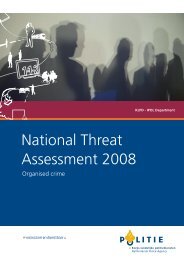Assessing the Effectiveness of Organized Crime Control Strategies ...
Assessing the Effectiveness of Organized Crime Control Strategies ...
Assessing the Effectiveness of Organized Crime Control Strategies ...
You also want an ePaper? Increase the reach of your titles
YUMPU automatically turns print PDFs into web optimized ePapers that Google loves.
<strong>Assessing</strong> <strong>the</strong> <strong>Effectiveness</strong> <strong>of</strong> <strong>Organized</strong> <strong>Crime</strong> <strong>Control</strong> <strong>Strategies</strong>:<br />
A Review <strong>of</strong> <strong>the</strong> Literature<br />
attack upon local OC by identifying <strong>the</strong> power structure <strong>of</strong> <strong>the</strong> local OC family, targeting key<br />
individuals within <strong>the</strong> organization, and initiating prosecutions that were most likely to seriously<br />
disrupt its operations. The Buffalo Strike Force operated until <strong>the</strong> end <strong>of</strong> 1968 and brought<br />
indictments against more than 30 individuals involved in OC (General Accounting Office,<br />
1989:8).<br />
Because <strong>of</strong> <strong>the</strong> apparent success <strong>of</strong> <strong>the</strong> Buffalo Strike Force, <strong>the</strong>se forces were established<br />
throughout <strong>the</strong> US. As <strong>of</strong> February 1989, <strong>the</strong>re were 14 such strike forces. The strike forces<br />
concentrated <strong>the</strong>ir efforts on La Cosa Nostra and succeeded in convicting high-level OC figures<br />
in Boston, Chicago, New York, Milwaukee, and Cleveland (General Accounting Office,<br />
1989:14). Many <strong>of</strong> <strong>the</strong>se individuals received lengthy prison sentences. However, no<br />
information is available from <strong>the</strong> 1989 audit as to <strong>the</strong> number <strong>of</strong> indictments or convictions<br />
achieved. An earlier audit revealed that strike forces convictions, including those <strong>of</strong> highechelon<br />
figures, <strong>of</strong>ten yielded non-custodial or short prison sentences (General Accounting<br />
Office, 1977:24-27). However, no comparison is provided in terms <strong>of</strong> <strong>the</strong> conviction rates or<br />
sentences imposed for comparable cases prosecuted by <strong>of</strong>fices o<strong>the</strong>r than <strong>the</strong> strike forces.<br />
The General Accounting Office (1989:27; 1977:17) lamented <strong>the</strong> fact that no overall measures <strong>of</strong><br />
effectiveness were established for <strong>the</strong> strike forces. Notwithstanding <strong>the</strong> lack <strong>of</strong> an evaluation<br />
strategy, <strong>the</strong> GAO (1977:7), in its 1977 audit, declared <strong>the</strong> strike forces unsuccessful because<br />
<strong>the</strong>re had been no coordinated national effort to fight OC. Ra<strong>the</strong>r, “ Federal efforts against<br />
organized crime are more <strong>the</strong> result <strong>of</strong> individual decisions made at <strong>the</strong> local level than <strong>the</strong> result<br />
<strong>of</strong> a national strategy, as originally envisioned…In practice, each participating agency fights<br />
organized crime as it sees fit” (General Accounting Office, 1977:7). Variations in <strong>the</strong> definition<br />
<strong>of</strong> OC and <strong>the</strong> lack <strong>of</strong> agreed-upon aims were seen by <strong>the</strong> GAO as contributing to this failure.<br />
In addition, jurisdictional disputes arose between <strong>the</strong> strike forces and US Attorney’s Offices<br />
(General Accounting Office, 1989:21). US Attorneys are <strong>the</strong> chief federal prosecutors in <strong>the</strong><br />
judicial districts and <strong>the</strong>y, too, prosecute OC cases in <strong>the</strong> same regions covered by <strong>the</strong> strike<br />
forces. The conflicts and coordination problems led to <strong>the</strong> call by an advisory committee to<br />
phase out <strong>the</strong> strike forces and to integrate <strong>the</strong>m within <strong>the</strong> US Attorneys’ Offices as early as<br />
1974. The strike forces were ultimately disbanded in 1989 as independent entities and were, in<br />
fact, merged into US Attorneys’ Offices. As a result, many experienced strike force prosecutors<br />
resigned from <strong>the</strong> US Justice Department (Jacobs and Gouldin, 1999:160).<br />
<strong>Organized</strong> <strong>Crime</strong> Drug Enforcement Task Forces, headed by US attorneys, were established in<br />
1983 to identify, investigate, and prosecute high-level drug traffickers (General Accounting<br />
Office, 1989). Their aim was to eliminate high-level drug operations through <strong>the</strong> coordination <strong>of</strong><br />
federal resources. As <strong>of</strong> 1989, <strong>the</strong>re were 13 drug task forces in <strong>the</strong> US and participating<br />
agencies included US attorney <strong>of</strong>fices, Drug Enforcement Administration, FBI, US Customs<br />
Service, US Marshals Service, Bureau <strong>of</strong> Alcohol, Tobacco, and Firearms, Internal Revenue<br />
Service, <strong>the</strong> Coast Guard, and state and local law enforcement agencies. Housed in US<br />
Attorneys’ Offices, assistant US attorneys work with <strong>the</strong> initiating law enforcement agency in<br />
establishing electronic surveillance, engaging in undercover operations, using investigative grand<br />
juries, administering asset forfeitures, and performing o<strong>the</strong>r activities usually required in<br />
complex drug investigations (Lyman and Potter, 1997:430-431).<br />
42 | Research and Statistics Division / Department <strong>of</strong> Justice Canada








